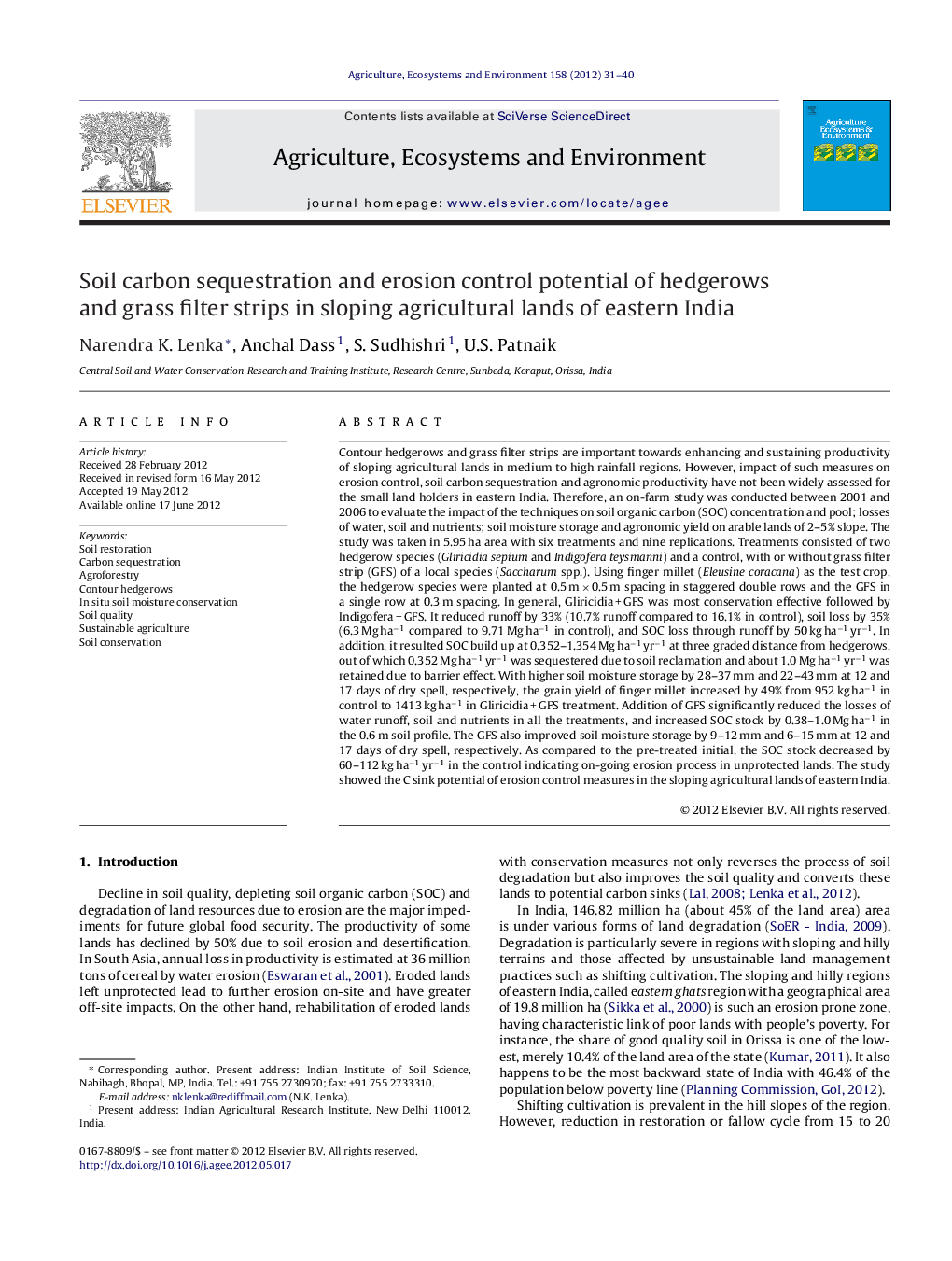| کد مقاله | کد نشریه | سال انتشار | مقاله انگلیسی | نسخه تمام متن |
|---|---|---|---|---|
| 2414488 | 1552094 | 2012 | 10 صفحه PDF | دانلود رایگان |

Contour hedgerows and grass filter strips are important towards enhancing and sustaining productivity of sloping agricultural lands in medium to high rainfall regions. However, impact of such measures on erosion control, soil carbon sequestration and agronomic productivity have not been widely assessed for the small land holders in eastern India. Therefore, an on-farm study was conducted between 2001 and 2006 to evaluate the impact of the techniques on soil organic carbon (SOC) concentration and pool; losses of water, soil and nutrients; soil moisture storage and agronomic yield on arable lands of 2–5% slope. The study was taken in 5.95 ha area with six treatments and nine replications. Treatments consisted of two hedgerow species (Gliricidia sepium and Indigofera teysmanni) and a control, with or without grass filter strip (GFS) of a local species (Saccharum spp.). Using finger millet (Eleusine coracana) as the test crop, the hedgerow species were planted at 0.5 m × 0.5 m spacing in staggered double rows and the GFS in a single row at 0.3 m spacing. In general, Gliricidia + GFS was most conservation effective followed by Indigofera + GFS. It reduced runoff by 33% (10.7% runoff compared to 16.1% in control), soil loss by 35% (6.3 Mg ha−1 compared to 9.71 Mg ha−1 in control), and SOC loss through runoff by 50 kg ha−1 yr−1. In addition, it resulted SOC build up at 0.352–1.354 Mg ha−1 yr−1 at three graded distance from hedgerows, out of which 0.352 Mg ha−1 yr−1 was sequestered due to soil reclamation and about 1.0 Mg ha−1 yr−1 was retained due to barrier effect. With higher soil moisture storage by 28–37 mm and 22–43 mm at 12 and 17 days of dry spell, respectively, the grain yield of finger millet increased by 49% from 952 kg ha−1 in control to 1413 kg ha−1 in Gliricidia + GFS treatment. Addition of GFS significantly reduced the losses of water runoff, soil and nutrients in all the treatments, and increased SOC stock by 0.38–1.0 Mg ha−1 in the 0.6 m soil profile. The GFS also improved soil moisture storage by 9–12 mm and 6–15 mm at 12 and 17 days of dry spell, respectively. As compared to the pre-treated initial, the SOC stock decreased by 60–112 kg ha−1 yr−1 in the control indicating on-going erosion process in unprotected lands. The study showed the C sink potential of erosion control measures in the sloping agricultural lands of eastern India.
► C sink potential of selected erosion control measures was studied.
► The best combination was Gliricidia hedgerow with Saccharum spp. as grass filter.
► C sequestered in the 0.6 m soil depth was 0.41–1.42 Mg ha−1 yr−1.
► Higher soil moisture by 22–43 mm in dry spell, increasing grain yield by 49%.
► Addition of grass filters improved the conservation potential of hedgerow species.
Journal: Agriculture, Ecosystems & Environment - Volume 158, 1 September 2012, Pages 31–40